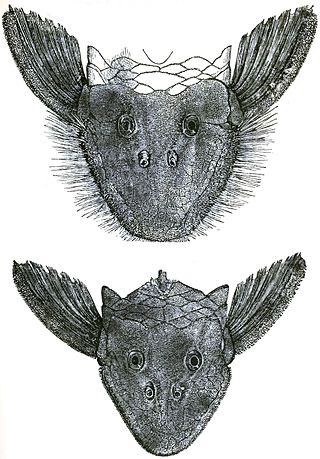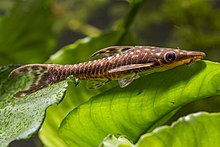
Loricariidae is the largest family of catfish, with over 90 genera and just over 680 species. Loricariids originate from freshwater habitats of Costa Rica, Panama, and tropical and subtropical South America. These fish are noted for the bony plates covering their bodies and their suckermouths. Several genera are sold as "plecos", notably the suckermouth catfish, Hypostomus plecostomus, and are popular as aquarium fish.

Otocinclus is a genus of catfish in the family Loricariidae native to South America, commonly known as "dwarf suckers" or "otos". This genus, like other loricariids, is characterized by rows of armour plating covering the body, as well as the underslung suckermouth. They are generally small in size; O. tapirape is the smallest of the species (2.4 cm), while O. flexilis is the biggest (5.5 cm). These species have adaptations that allow them to breathe air. A duct forms at the junction between the esophagus and the stomach and expands into an enlarged, ring-like diverticulum, characteristic of this genus, which allows air-breathing. Otocinclus are popular aquarium fish, and they are often purchased as algae eaters. It is difficult to breed them in captivity, and only wild caught Otocinclus are available to hobbyists. This genus is widely distributed east of the Andes of South America, throughout the lowlands from northern Venezuela to northern Argentina, but are generally absent from the Amazon and the Orinoco lowlands.

Pseudancistrus is a genus of suckermouth armored catfishes native to South America.

Rineloricaria is a genus of freshwater tropical catfish belonging to the family Loricariidae. They are commonly called whiptail catfish because of the long filament that grows out of the tip of the caudal fin that is characteristic of the genus. With the exception of R. altipinnis from Panama, they are native to the rivers of northern and central South America. Some species are regularly seen in the aquarium trade.
Lithogenes is a genus of South American catfish of the family Loricariidae. It is the only genus within the subfamily Lithogeneinae.
Epactionotus is a genus of armored catfishes native to South America.

The Hypoptopomatinae are a subfamily of catfishes of the family Loricariidae, composed of 17 genera and approximately 80 species. This subfamily represents about one-tenth of all loricariid species.
Oxyropsis is a genus of fish in the family Loricariidae native to South America. These species are distinguished by the presence of a single row of enlarged odontodes along the trunk midline lying adjacent and immediately dorsal to, the lateral line canal. Species of this genus have a depressed head and have relatively large eyes placed ventrolaterally. This genus is most similar to Hypoptopoma in external appearance, which shares the head shape and eye placement. Oxyropsis are elongate and have a narrow caudal peduncle, which distinguishes it from all other Hypoptopomatinae genera except Niobichthys and Acestridium.
Hisonotus is a genus of armored catfishes native to South America. Species of Hisonotus and Curculionichthys are the only representatives of the subfamily Otothyrinae having serrae on the posterior edge of the pectoral fin spine. These species are small fishes, generally found in small fast flowing streams, where they grasp to the branches and leaves of aquatic or subaquatic plants. The species of this genus mostly occur in Atlantic coastal streams of southern Brazil and the Paraguay-Paraná system of southern South America. They are also distributed in the Río de La Plata basin and coastal rivers of southeastern Brazil.

Parotocinclus is a genus of fish in the family Loricariidae native to South America. This genus is distributed through almost all hydrographic systems in South America from the Guyana Shield drainages and Amazon Shield tributaries to the coastal drainages of eastern and southeastern Brazil, including the rio São Francisco basin. Most species have the caudal peduncle oval in cross section. It has been found that Characidium species may interact with P. maculicauda. The small Characidium will follow grazing P. maculicauda, which release particulate matter dislodged from the catfish's foraging.
Hypoptopoma sternoptychum is a species of catfish of the family Loricariidae.

Panaqolus is a genus of small catfish in the family Loricariidae native to rivers in tropical South America. Its members were formerly thought to belong to a clade of small-sized species in the genus Panaque, until this genus was separated from Panaque in 2001. At times it has been considered a subgenus of Panaque, and the validity of the genus has been disputed by various authors and sources. Pseudoqolus koko was formerly considered to be a member of this genus, although it was reclassified as a member of the currently monotypic genus Pseudoqolus by Nathan K. Lujan, Christian A. Cramer, Raphael Covain, Sonia Fisch-Muller, and Hernán López-Fernández following a 2017 molecular phylogenetic analysis.
Scott Allen Schaefer is an American ichthyologist working at the American Museum of Natural History as the dean of science for collections, exhibitions, and the public understanding of science; he serves as the curator-in-charge, in the department of ichthyology, within the division of vertebrate zoology.
Hypoptopoma baileyi is a species of catfish of the family Loricariidae.
Hypoptopoma bianale is a species of catfish of the family Loricariidae.
Hypoptopoma brevirostratum is a species of catfish of the family Loricariidae.
Hypoptopoma elongatum is a species of catfish of the family Loricariidae.
Hypoptopoma incognitum is a species of catfish of the family Loricariidae.
Hypoptopoma machadoi is a species of catfish of the family Loricariidae.
Hypoptopoma muzuspi is a species of catfish of the family Loricariidae.







